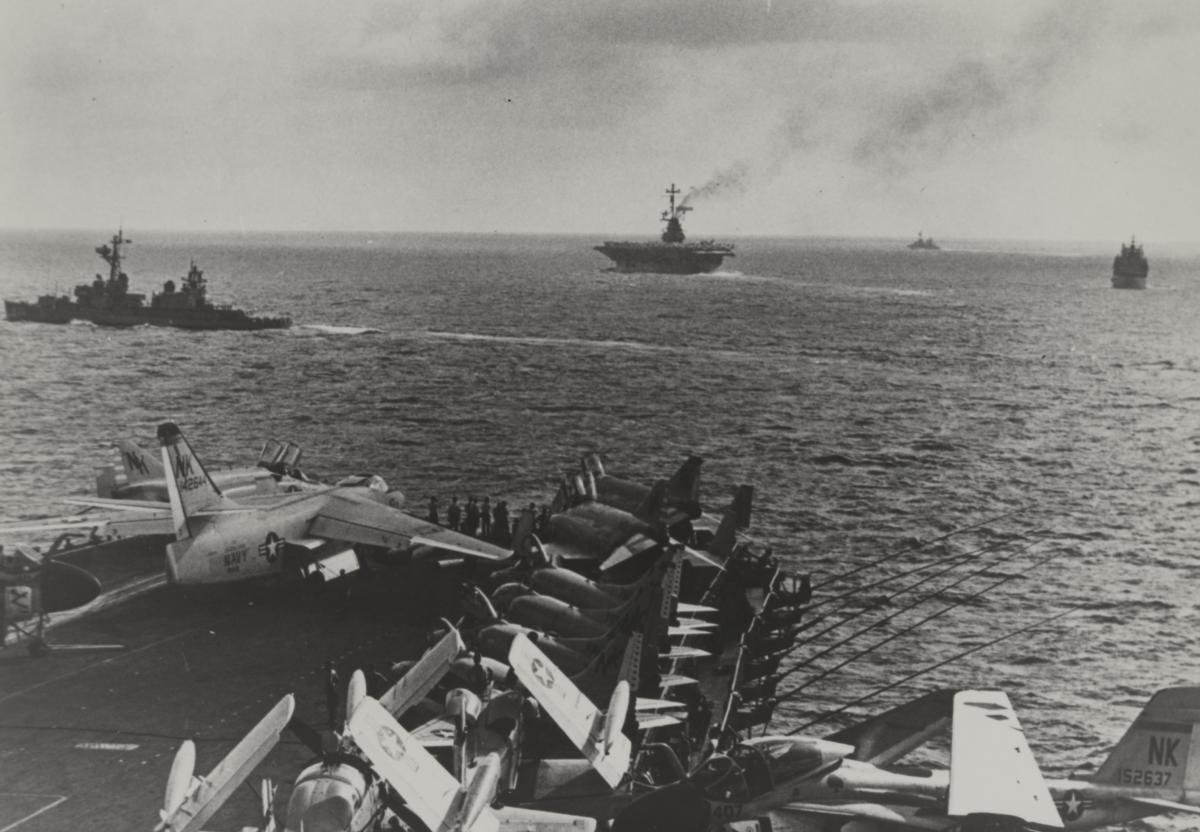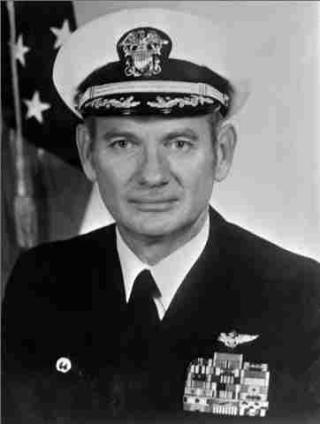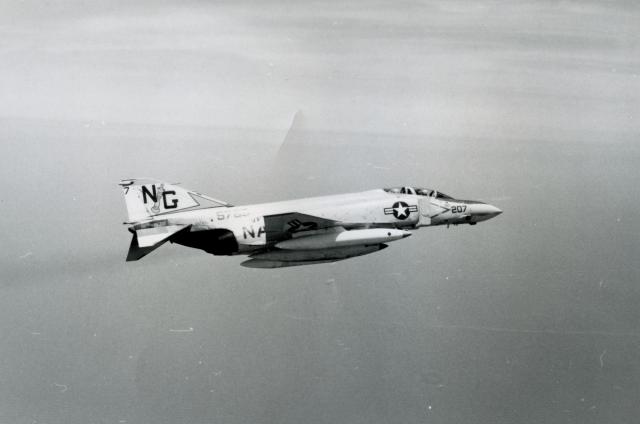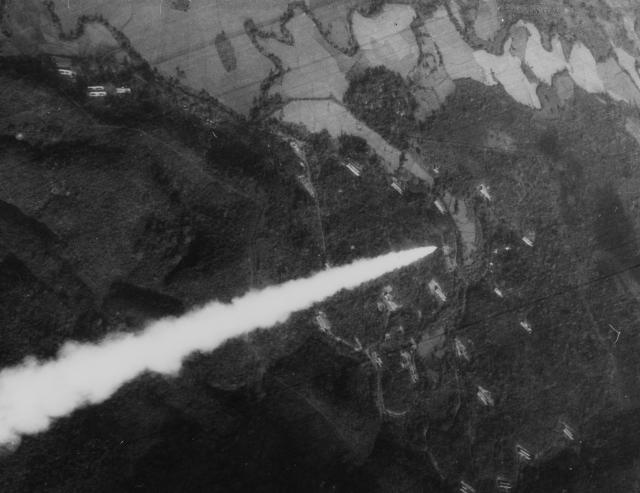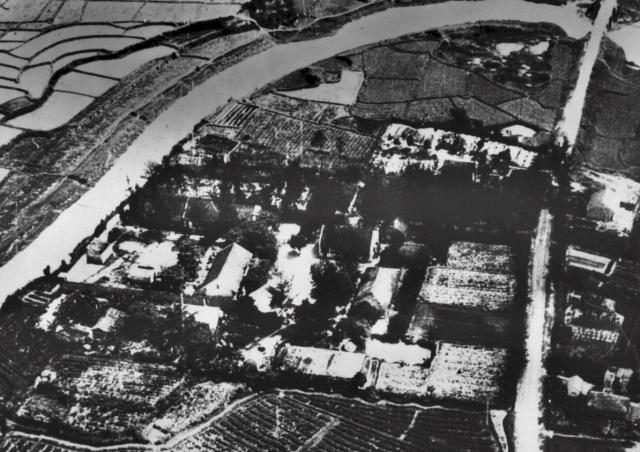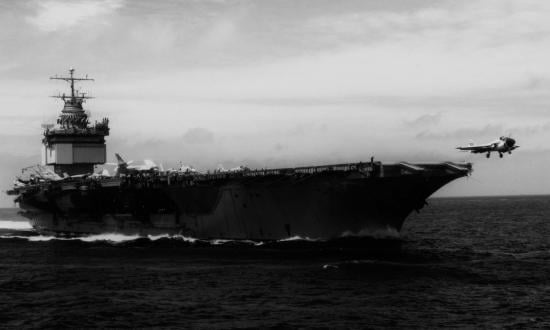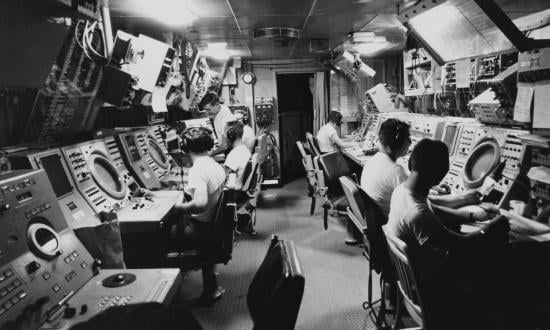Last of Three Parts
As I began to look for still-available personnel from the Navy’s Task Force 77 to gather details about their participation in the Son Tay raid, my first, and the very best, contact was retired Rear Admiral “Boot” Hill. He provided me with many addresses, emails, and phone numbers of key people with whom he still maintained contacts.
The best one of these was his former intelligence officer, retired Captain P. D. Hoskins, who remembered everything about the genesis of their OPORD and how it was executed. “Boot” Hill also read some drafts of stories I was able to collect from individuals who began referring me to other participants. “Boot” wanted me to get a better grasp on carrier operations, and arranged for me to fly to the USS Constellation (CV-64). She was off the coast of California preparing for her last operational deployment to the Persian Gulf. I spent three memorable days and two nights as her sole VIP guest. My escorts showed me everything I wanted to see and were glad to answer all my questions about carrier operations.
(U.S. Navy)
“Boot” Hill also arranged for me to meet Rear Admiral “Jig Dog” Ramage in San Diego for a very productive encounter. That is when he promised me to give me his unpublished story “Carrier Task Force 77 and the Son Tay Raid.” With all that help I produced my story about the “U. S. Navy in the Son Tay Raid” for distribution to attendees of the Son Tay Raiders Association reunion in Las Vegas in 2003. I donated that article to Air Force Historical Research Agency at Maxwell Air Force Base in Alabama.
After that I continued with my still-available 40-plus naval contacts to produce the first detailed published account about the diversion in my book The Son Tay Raid: American POWs in Vietnam Were Not Forgotten. It was well received by all who had assisted me in telling the Navy’s story and helped to generate more interest in my subsequent lectures on the effects of the diversion on the tactical success of Operation Kingpin.
‘A Convincing Mock Attack’
To fully appreciate the greatness of the Navy’s contribution we must go beyond Vice Admiral Bardshar’s enthusiastic support to deliver a convincing mock attack to test the North Vietnamese air defense network. We need to share his secret manipulation to get the three carriers on station in time for the raid and then the hurried preparation for launching the aircraft within less than nine hours of notice. We need to mesh the Air Force and Navy execution minute-by-minute to see the genius of Bardshar’s planning staff.
The most crucial time for the Joint Contingency Task Group (JCTG) Combat Talon, escorting formations of Jolly Green Giant helicopters and A1-E fighters, occurred between 0141 and 0154, when they flew within the line of sight of early warning radar at Na San, west of the mountain range. Helicopters were exposed for more than four minutes and the fighter formation for more than three. Electronic warfare officers (EWOs) in each escorting Talon monitored the rotating scan of this radar and assured us we were passing by undetected. Perhaps the crew who operated this early warning radar was already interested in monitoring the appearance of ten KC-135 tankers in their normal Laotian refueling orbits and the arrival of the first F-4s and F105s that were beginning to top off their fuel tanks. We were hoping that this is what would occur. Such congregation of aircraft signaled impending high-altitude attack. The formations were as low as they could be within the margin of safety, and they would not pose the same threat as the high-flying jets.
Meanwhile, on board the USS Oriskany, Rear Admiral Ramage moved between the bridge and the flight deck overseeing aircraft launches. Vice Admiral Bardshar stayed out of the way, but he monitored what was happening in the air. He had an ideal and technologically up-to-date setup with the Wainwright’s PIRAZ coverage and the NTDS communications tie-in. That gave him a complete picture of the Gulf area and of the North Vietnamese land mass all the way to the mountains past the Black River. He could see big screens with real-time displays of airborne aircraft and follow them as they moved through the skies from one planned turning point to another. He could monitor aircraft radio frequencies and listen to radio transmissions of naval air crews. He also had access to what the enemy was saying over the airwaves. Interpreters on airborne EP-3 would translate commands generated by the North Vietnamese defense network and provide timely inputs on enemy responses to the attack.
The Wainwright’s radar information also was displayed on big screens at the Monkey Mountain Tactical Control Center–North Sector, where Brigadier General Manor and his staff could see the start of the diversion. At first glance, the greenish glow displays appeared to show a disorganized group of small semicircles that represented friendly aircraft moving in every possible direction. But a prolonged look at each screen would reveal that there was a precise order to each aircraft’s movement. Each had a definite air space to go to and then depart from at a predetermined time.
Bardshar knew the battle plan layout with its numerous geographical points identified by numbers, letters of the alphabet, proper names like “MARY” and “ALICE,” or even favorite beers like “SCHLITZ” and “BUDWEISER.” He observed the screens with satisfaction as the naval forces moved in for their carefully staged mock attack. Everything was unfolding as planned. All aircraft were transmitting IFF (Identification Friend or Foe) that identified them to the PIRAZ radar controllers, giving them their speed, direction, and altitude. Aircraft were crossing their predetermined positions and the eavesdropping interpreters reported that the North Vietnamese radars were already hot.
Lit-Up Horizon East of Hanoi
Then, in the west, at about 0205, when the Air Force formations crossed the last mountain range into the Black River Valley, crew cockpit occupants of all 13 aircraft witnessed an incredible view of the far horizon east of Hanoi illuminated by still burning parachute flares jettisoned by Navy A-7s on tracks Alpha and Bravo. The EWOs focused their attention on all known radars they had plotted on their maps of the river basin west of Hanoi. All radar signals were coming from where they should be, but none were targeting our low flying formations intruding into their air space. It was clear that the North Vietnamese air defense system had not received, or had failed to respond to, messages from operators of the early warning radar at Na San. That radar site must have detected and reported flights of five F-105s and five F-4s heading toward Hanoi.
Diversion by the Navy in the east must have generated such confusion at the command level that they neglected to pay attention to what was developing in the west. This is exactly what the Air Force air operations planners wanted. They also wanted to ensure that the North Vietnamese would keep the MiG interceptors down and opt instead for using surface-to-air missiles. Their support role was not only to protect the low-flying formations, but also to present the enemy antiaircraft defenses with inviting targets for surface-to-air missiles (SAMs). The Air Force had eight high-flying jets in the air—four F-105 Wild Weasels and four F-4 MiG killers—throughout the ground operation. Each foursome had one spare aircraft in orbit west of the Black River, ready to take over for any one that got shot down or disabled. Similarly, we had four A-1Es flying at up to 3,000 feet over Son Tay providing close air support for the ground troops. These also had one spare in orbit west of the river. The Wild Weasel F-105s and MIGCAP F-4s arrived unopposed and untargeted at their respective defensive stations at about 0208 and 0210.
A Disoriented Response
(U.S. Air Force)
Brigadier General Manor’s report on the North Vietnamese defenses differs only by several minutes from the times recorded in North Vietnam’s histories. His is based on reports of radar activity detected and recorded by electronic countermeasures equipment in both formation leading aircraft. It reads: “From 2:04 until 2:24 a.m. local time the NVN [North Vietnamese] Air Defense System was in the process of increasing alert and establishing targets.”1 Emissions from detected surveillance radars were coming from known locations, and there were no indications of air defense alertness. It was obvious that the NVN either were not alerted by Na San’s early warning radar west of the mountains or ignored its reports of refueling tankers in orbit over Laos and then heading toward Hanoi.
The NVN report reads: “At the 361st Air Defense Division, after receiving the reports of enemy activity, Deputy Commander Dinh Dinh Sanh ordered the entire division to Condition One on an immediate basis. This was done at 2:18 a.m. At 2:26 the entire division was ready for battle.”2 Our records show that the first SAM targeting occurred at 0228, which suggests that their time of 0218 is not correct. Time of 0208 corresponds to the arrival of the F-105 Wild Weasels. Normally, it took NVN defenses about 20 minutes to get ready to launch missiles after first aircraft detection. Wild Weasels recorded first targeting by SAMs at 0228. There is also something very curious about this cited source. It contains periodic statements about SAM battalions targeting aircraft beyond 12.5 miles without launching their rockets. It suggests that all launches in the west occurred when the aircraft were inside of a 12.5-mile distance.
There must have been disorientation in their air defense network because they also failed to respond to a report from a mountain observation station about sound of helicopters heading to the east. Our helicopter formation flew a 14.7-mile dog leg between 0156 and 0204, descending from 5,500 to 4,000 feet. The highest peak, measuring 4,593 feet, was two miles north of this track. It was the likeliest location for this facility that we did not know about. North Vietnamese air defense historians recorded the following about the sound of eastbound helicopters: “Our visual observation station at Suoi Rut identified the sound of their engines and quickly reported this fact to command headquarters at all levels.”3 Again, the previously referenced NVN History of the Air Defense Service records that the 361st Air Defense Division did not respond until 0218.
Aerial Targets Out of Range
Commander Weston “Ham” Byng led the “Iron Hand” A-7s. His paired-off wingman aborted on the deck and he ended up in his SAM-suppressing orbit at 32,000 feet by himself. Consequently, he had no one protecting his back when he flew eastbound on his assigned track. He was continuously scanned, but that was no problem. The site that targeted him was too far away and he felt safe. He observed several SAMs rise high to their burnout altitudes and then self-destruct. All naval aircraft were on tracks and orbits that were out of harm’s way. “Ham” Byng observed one SAM burn out at about 30,000 feet when he headed inland. He considered that enough of a threat that he launched one of his Shrike missiles, hoping to get someone’s attention even though he knew it was outside of its effective range.4 His was one of the only three Shrikes fired by the Iron Hands. Twenty NVN missiles that were launched against the Navy detonated without reaching their out-of-range targets.
Lieutenant “Bull” Durham, VF-194’s safety officer from the USS Oriskany, flew a BARCAP (Barrier Combat Air Patrol) mission in his F-8. He also was well out of range of any NVN defenses. Never targeted in his orbit, he later commented: “It was quite a show from my vantage point: hundreds of flares up north, nonstop SAM launches. Nobody was anywhere near the SAM sites, so the NVN launched them straight up in barrage mode. Still, it was more hostile fire in two hours than I had seen in two cruises.”5
Lieutenant James H. Oliver had a different angle’s view of this one-sided air battle. He flew on track Bravo, which dropped flares over land northeast of Hanoi. His flare-dispensing A-7 also was well out of harm’s way. He was so bothered by the intense strobing of his electromagnetic equipment that he turned it off and watched the lit-up scenery below him.6
There is only one answer as to why the NVN defenses were not ready for the Air Force aircraft over Son Tay. They were thoroughly confused and preoccupied by what the Navy was doing just outside of the effective kill zones of their antiaircraft artillery (AAA) and SAM defenses.
Senior Colonel Le Co, former air defense missile combat training officer, is perhaps the highest-ranking official who expressed his recollection of what had transpired at the air defense command post in Hanoi. He is credited as one of the authors of the “Red Book” (the manual for shooting down B-52s), in which he predicted directions from which the aircraft would make their attack and came up with plans to fight back.7 His tactics were successfully employed during Linebacker II in late 1972. He posed as a retired lieutenant colonel who acted as a tour guide for retired USA Special Forces Major Solomon V. Binzer during his escorted visit to the Son Tay POW camp in 1994. Binzer was not aware of Le Co’s true identity. He was delighted to learn that Binzer had a background in antiaircraft missile defenses, and as retired veterans they shared some of their military service experiences.. This is how Binzer recorded the event in his memoirs:
As we walked and talked, Le Co told me he was on duty at his SAM site headquarters in the Hanoi area on the night of the raid. He said it was a very confusing situation. He told me that his headquarters could not get any other regional headquarters on the telephone. That is one of the freakish things, the fog of war; the telephone system around the country was being repaired that day, and communication was difficult. So when the U.S. Navy began to fly over the port of Haiphong that night and not drop bombs but just drop flares, nobody could figure out why. He said they could see the flares but could not talk to the Haiphong area because the phone lines were out. And, they did not know about the raid at Son Tay.”8
North Vietnamese histories of the war, as well as our own intelligence sources, make no comment about the telephone repairs and the confusion in communications, but here is one highly decorated North Vietnamese air defense officer, who as a lieutenant colonel admitted that he was in the midst of the confusion brought about by the U.S. Navy’s convincing show of force. Their historians did not address the bewilderment and confusion the Navy caused them. Instead they focused on the shortcomings of their air defenses in the Son Tay area:
The primary reason for this shortcoming was a low spirit of combat readiness and our failure to anticipate that the enemy would use helicopters supported by fighters to make such a deep penetration into our rear area to rescue their pilots. It was for this reason that, when the situation developed, our commanders at all levels reacted passively and clumsily to engage enemy forces in the air, and we had no specific plan to engage enemy forces on the ground. Our commanders lacked flexibility in their handling of the situation; we did not utilize our air force fighters to engage the enemy; our communications arrangements proved to be weak; our combat effectiveness was low; and we failed to shoot down any enemy aircraft on the spot.
This raid provided our air defense-air force troops a profound lesson in many different areas, and especially in preparing for and then implementing plans to combat enemy forces landing from the air deep in our rear areas in North Vietnam. After this incident, the Air Defense–Air Force Service Party Committee and the Air Defense Command conducted self-criticism and directed all headquarters staffs and units to hold sessions to review this experience, to derive lessons learned, to conduct stern self-criticism of each element’s performance, and to take concrete corrective action.”9
(U.S. Naval Institute Photo Archive)
There was a big difference between the two air battles. None of the Navy’s 59 aircraft had to take evasive actions while they flew in assigned routes and orbits. There were seven active SAM sites and an unknown number of AAA batteries in the Son Tay area. AAA Firecans and SAM Fansongs radars had eight fast-flying jets and four slow-flying prop planes within their effective kill zones. AAA batteries were ineffective and did not score a single hit. Their tracer rounds were bothersome sights, but they appeared to aim at the sounds of the aircraft overhead of their locations. It was much different with the SAMs that started launching at 0235. By that time the ground operation at the POW camp was over, and the raiders were boarding the helicopters. Safe exit from the active overhead hornet’s nest became everyone’s concern.
Fortunately, the enemy was still focusing on the high-flying F-4s and F-105s. At 0240, a Wild Weasel Firebird 3 was damaged by a SAM but was able to land at Udorn. A spare Firebird 5 replaced it and promptly was hit by another SAM at 0246. Exploding missile ruptured its fuel tank and the Firebird 5 had to exit and head for C-135 tankers loitering in refueling orbits over Laos. Unfortunately, it flamed out before it could reach an alerted KC-135 tanker. Its two-man crew had to bail out. Fortunately, they parachuted safely and were rescued by two of the returning HH-53 helicopters.
Lieutenant Colonel Robert J. Kronebusch, who commanded the Wild Weasels from Firebird 1, lost two of his five planes in six minutes. He immediately ordered the remaining three to move west out of the kill range. “I called Firebird flight to move westward five miles. My reasoning was that SAM sites did not appear to fire at us when we 15 miles or more, although 15 miles was in their range. Only when we reduced the distance to less than 15 were we fired on.”10 Kronebusch was the last Weasel to depart from the area at 0255. He headed for the Plain of Jars in Laos where Firebird 5’s pilot Major Donald W. Kilgus and his EWO Captain Clarence T. Lowry awaited their rescuers.
‘The Magnificent Distraction’
Much has changed in Vietnam since the end of the war. In 2020, the Vietnamese newspaper Soha published a victorious story about the attempted rescue of American prisoners. Its title is “Vietnam’s Air Defense Missiles Shatter the Son Tay American POW Rescue Mission: An Outstanding Combat Achievement.” NVN’s air defenses defeated American air power by shooting down two F-4 jet aircraft. These two victories were credited to the 43rd and 44th Missile Battalions of the 263rd Missile Regiment. For its high state of combat readiness, the 263rd was awarded a floral wreath for its performance, and the Air Defense–Air Force Service Command Headquarters awarded the regiment two banners commemorating this especially outstanding achievement!11 Even though the Soha article did not report the type of shot-down aircraft correctly, it contains the following admission:
Before the helicopters landed at the Son Tay prison camp, the U.S. Navy sent four flights of aircraft to operate off the coast of Haiphong. They dropped flares in the areas of Van Hoa and Long Chau Islands to divert our attention, and many jet aircraft flew at medium altitudes, circling in the Hanoi area, to force us to disperse our defensive efforts.
(Department of Defense)
The air situation at that time was complicated and very tense. In the black of night alarm sirens sounded in the provinces and cities of North Vietnam, accompanied by the roar of engines from flights of jet aircraft and the constant explosions of bombs and antiaircraft shells.
Fighting at night was harder for our air defense troops because the enemy was equipped with many types of modern night-fighting and night reconnaissance instruments that enabled the enemy to make rather accurate attacks. As for our side, except for our missile troops, our antiaircraft artillery (AAA) and anti-aircraft machine-gun forces could not see their targets, so they were forced to fire barrages aimed at the sound of aircraft engines or to put a curtain of fire at certain ranges and certain altitudes to protect vital installations. This meant that their efforts were not very effective.12
We must wonder what could have happened to the five Wild Weasel F-105s and ten MIGCAP F-4s, without the magnificent distraction staged by the Navy. The North Vietnamese 361st Air Defense Division did not receive report of enemy activity until 0218. That was when Combat Talon Cherry 1 broke radio silence by calling “Alpha, Alpha, Alpha” and dropped four flares to light up the prison camp. The diversion not only allowed the low-flying aircraft to arrive at the target undetected, but also gave our air-cover jet aircraft precious minutes of survivability.
The timing of the diversion was excellent. It couldn’t have been better. The raiders can never give Vice Admiral Bardshar’s planners enough credit for the excellence of their OPORD. Likewise, the most credible diversion Bardshar promised was just that. Air Force planners did not expect such number of aircraft. Performance of naval aviators was flawless, without any incidents. All carrier personnel who participated rose to the occasion without being aware what this very short-notice operation was all about.
The Navy performed brilliantly. This was never lauded enough after the raid. The real heroes were the Green Berets. They did the work on the ground and faced the enemy’s bullets. The Air Force got them safely there and brought them back. Accolades and high decorations went to them. The Navy’s participation that contributed so valuably to the Air Force’s ease in getting the raiders in and out fell into the category of a routine operation. Part of it was due to Bardshar’s order forbidding publicity of this event even after its occurrence. Task Force 77 did not have a representative at the detailed post-mission debriefing at Eglin Air Force Base, which could have provided fresh accounts of how the diversion was conducted. The JCTG submitted award recommendations only for those individuals who were on temporary duty orders to it. Recommendations for supporting units, not on orders to the JCTG, were left up to the commanders of their respective units.
The Navy was very humble about its participation in the raid on Son Tay. What became the largest nighttime operation of the Vietnam War was recorded only as a significant operation in the 1970 Command History Reports for campaigns spanning the entire presence of carriers and their wings, groups, and squadrons at Yankee Station. All carriers and assigned air units received Meritorious Unit Commendations (MUCs) for the period of their service in the Gulf of Tonkin. MUC citations for the USS Hancock and Ranger have specific references to the diversionary strike. Citation in CHNAVPERS letter PERS-p53-IBP/kmc of 17 November 1971 for the Ranger states: “Ranger arrived in the Tonkin Gulf on 18 November 1970 and participated in the diversionary action of the Son Tay Prisoner of War operations as well as Operation Freedom Bait.” The MUC citation for the Oriskany does not even mention the raid. Only the following flying squadrons made specific references to the Son Tay raid diversion in their Command History Reports:
USS Hancock with VAW-111-Det 19.
USS Oriskany with VF-191, VA-153, Va-155, and VAQ-130-Det 1.
USS Ranger with VF-21, VF-154, VAQ-134, and VAW-111-Det 6.13
Rear Admiral James D. Ramage, who commanded Task Force 77 during the diversion for the Son Tay raid from his flagship Oriskany, was honored to do so and shared it with his principal subordinates with the following words:
For those of us in the carriers, we were proud to be able to carry out an extremely difficult night mission without any rehearsal or warning. The preparation by Bardshar’s staff was superb and the execution by Air Wing 19 under CDR Doug Mow, Air Wing 2, commanded by CDR J. E. McKnight, and Air Wing 21 led by CDR G. H. Palmer, carried out the mission in an absolutely professional manner. It was an honor to be associated with them.14
1. Manor, JCTG Report, 12–13.
2. Sr. Col. Ho Si Huu, Sr. Col. Chu Thai, Col. The Ky, Lt. Col. Dinh Khoi Sy., and Lt. Col. Nghiem Dinh Tich, History of the Air Defense Service, Volume II, 341.
3. Huu et al., History of the Air Defense Service, 341.
4. CAPT Weston H. Byng, USN (Ret.), email to author, 21 April 2003.
5. “Bull” Durham, email message to author, 24 December 2002.
6. CDR. James H. Oliver, USN (Ret.), email to author, 19 January 2003.
7. Saigon Giai Phong [Liberated Saigon] newspaper, 16 December 2012.
8. MAJ Solomon V. Binzerm USA (Ret.), “My Visit to the Son Tay POW Camp,” 4.
9. Huu et all, History of the Air Defense Service, 343.
10. COL Robert J. Kronebusch, USAF (Ret.), “Wild Weasel after Action Report,” 2.
11. “Vietnam’s Air Defense Missiles Shatter the Son Tay American POW Rescue Mission: An Outstanding Combat Achievement,” Soha, 17 May 2020.
12. “Vietnam’s Air Defense Missiles Shatter the Son Tay American POW Rescue Mission.”
13. Letter from the Naval Historical Center to the author, 16 May 2001.
14. Ramage, “Carrier Task Force 77 and the Son Tay Raid,” 6.



